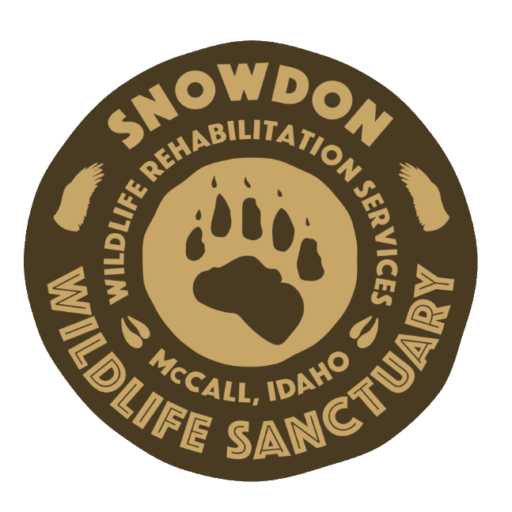The things we do for love

The Things We Do For Love
The journey to Snowdon Wildlife Sanctuary to become the new Wildlife Rehabilitator Manager was exciting, to say the least. Picture this… 10 months ago, leaving Vermont to work as a Registered Veterinary Technician at Big Bear Alpine Zoo and VCA Lakeside Animal Hospital in Big Bear Lake, California. Now, cut to… 3 weeks ago when roads up-and-down the mountain to Big Bear were closed due to the insane amount of snow being dumped… tons of snow… and more snow… and more. So much snow it was nearly impossible to throw it out of the way. Now picture 38 steep steps to climb to the front door. 38 steep steps to keep cleared of snow in order to pack the car to move to McCall, Idaho. Then, there were decks to clear to avoid collapse. The driveway. The unplowed roads. What does one do? They shovel… and shovel more… and more. Not only must one shovel out their home, but the job where they care for injured wildlife needs to be shoveled too… repeatedly… exhaustingly… painstakingly, because lives literally depended upon it… wild lives. Let us not forget that on top of shoveling, one had to pack, clean, and steam clean rugs because someone really wanted their security deposit back. The question over those two weeks of clearing snow and ice was… Will the landlords be able to make it for the walk-through, and will someone be able to leave on their moving day because, again, roads were closed, and only residents with proof of residency were allowed up and down the hill? Thankfully, when the day arrived to head out of town, roads were finally open to everyone.
The car is packed to the roof in every available space. The driver seat is erect, elbows snug to the body, and legs not any better. The seat position could not be moved back any further. Two large dogs shared breathing room only. And, literally, up to the very last moment when a decision had to be made, the question looming was… take scenic Highway 93 or go through Death Valley National Park? If ever there was a time to go, now is it. Annnnnnd… Death Valley it is! Made it there in time to appreciate the sunset at Zabriskie Point. Then, pitched the tent in the dark for the night. The dirt was hard as pavement, meaning stakes were nearly impossible to pound into the ground. Piling rocks was the go-to source that helped secure the tent in place. Winds packed a punch all night long, but we slept almost peacefully.
In the morning, the car was loaded once more. We proceeded to several scenic stops throughout the park, stretched our legs, admired the views, and marked a little territory here and there (two dogs, remember?). Do not fear. They did not desecrate anyplace where they were not allowed to go… and, as they say, have poop bags, will travel. They do say that… right? Anyway, here is the list of places we admired inside the park: Badwater Basin (282 feet below sea level), The Devil’s Golf Course, Mesquite Flat Sand Dunes, Artists Drive and Artists Palette. In a word, AMAZING!
After completing Death Valley, the next stop was Rhyolite Ghost Town to take in the Ruins, Tom Kelley’s Bottle House, Goldwell Open Air Museum, and a Cemetery. That night we chose to stay in a motel somewhere in Wells, Nevada. It was dark and snowing, and the mood to search for a place to camp was lost to the need for sleep. From there, the next day, Snowdon or Bust! It is a MUST to photograph the Extraterrestrial Highway Sign along the way. It is unearthly.
Upon crossing over the bridge above Snake River in Twin Falls, Idaho one must stop to admire the view and recall Evel Knievel’s attempt to jump across the river on a rocket-propelled motorcycle, albeit not at that specific stopping point. He did not make it, but he lived to talk about it.
Lastly, McCall, Idaho… Snowdon Wildlife Sanctuary. Upon arrival, the greeting was friendly and warm while demonstrating how life off-grid would work. Took the next day off to unpack and settle in and reflect on how much I love working with wildlife. The day after that, the winter intern, Bob, introduced the animals before heading to the roof, where we naturally cleared more snow and ice. Thank you, Jeff, for joining us! Two days later, it was back to shoveling more snow off the rooftop… but, truth be told, Bob was the muscle. Putty arms and zapped energy meant several breaks for this weary one to rest their head upon their shovel handle. Thank you, Bob! You ROCK! It would not have been completed without you.
Bob is leaving Snowdon in another week. He will be greatly missed. While the time working together was short, he is incredibly knowledgeable and fascinating to listen to. Wishing him nothing but pure joy and success on the next leg of his journey. He has accepted an exciting job opportunity where he will do incredible things for rivers and the environment. Cheers to you, Bob! We will see you down the road… or, down the river. Safely down the river.








